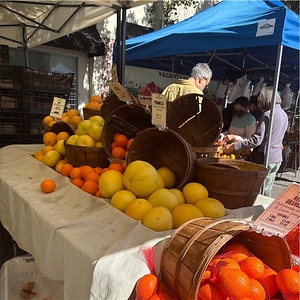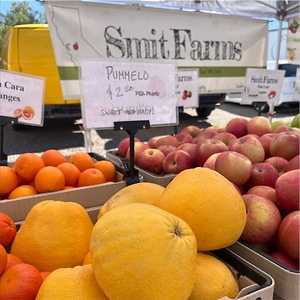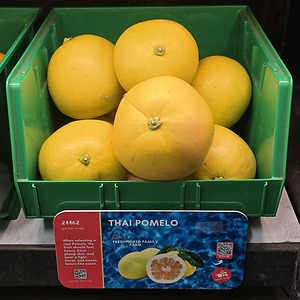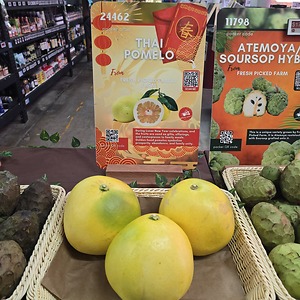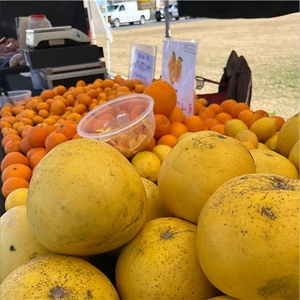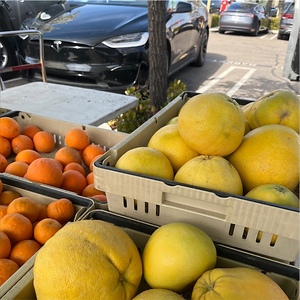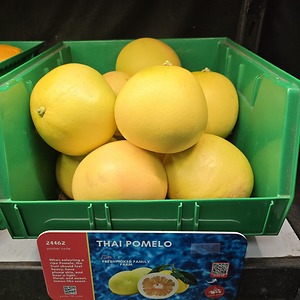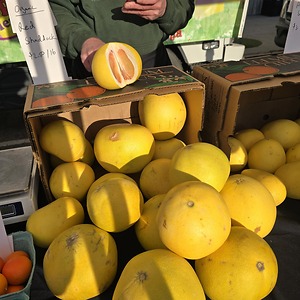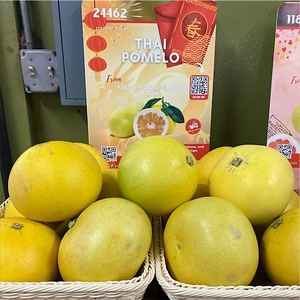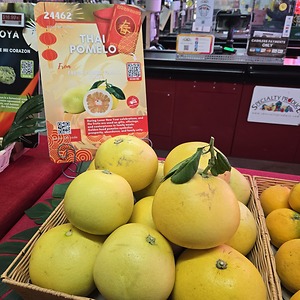


Pomelos
Estimated Inventory, lb : 0
Description/Taste
Pomelos are large fruits, averaging 15 to 30 centimeters in diameter, and have a round, oval, to tear-drop shape. The rind, also known as the peel, ranges in color from green, yellow-green, to bright yellow and bears many small, fragrant oil glands, creating a textured, finely pitted surface. Underneath the rind, there is a thick white pith with a spongy, cotton-like consistency that has a very bitter, unpalatable flavor and should be removed before consumption. The pith is easily peeled, revealing 11 to 18 segments of soft, tender flesh encased in membranes, which also carry a bitter flavor and should be discarded. Once peeled, the flesh is comprised of translucent sacs filled with juice and pulp, varying in pink, red, to yellow hues. Some varieties contain a few seeds, while other cultivars may contain significant amounts. Pomelos will vary in texture and flavor, depending on the variety, ranging from sweet, honeyed, and floral with tangy notes to sweet-tart with some acidity. When selecting a ripe Pomelo, the fruit should feel heavy, have plump skin, and bear a light, floral, and sweet, lemon-like scent.
Seasons/Availability
Pomelos are available year-round with a peak season in the winter through early spring.
Current Facts
Pomelos, botanically classified as Citrus maxima, are ancient fruits growing on evergreen trees belonging to the Rutaceae family. The sweet and tangy citrus is the largest species within the Rutaceae family and is native to Southeast Asia, highly prized for its size and flavor. Worldwide, there are many different types of Pomelos, with at least 22 known wild and cultivated varieties, and each cultivar will range in flavor and appearance. Pomelos are also known by regional names, including Jeruk Bali, Shaddock, Jabong, Jambola, Bali Lemon, and even the name Pomelo can be spelled Pummelo, Pommelo, Pumelo, and Pomello. It is important to note that grapefruits and Pomelos are two distinct species and are not the same fruit. Grapefruits are a hybrid species created from a cross between a Pomelo and sweet orange. Despite their names being used interchangeably in some countries, Pomelos are larger in size and generally have a sweeter flesh, while grapefruits are smaller, rounder, and often contain bitter, sweet-tart flavors.
Nutritional Value
Pomelos are an excellent source of vitamin C, an antioxidant that strengthens the immune system, reduces inflammation, and protects the body against free radicals. The fruits are also a good source of copper to maintain a healthy nervous system, potassium to balance fluid levels within the body, and provide lower amounts of phosphorus, fiber, and calcium.
Applications
Pomelos have a sweet, tangy flavor well-suited to both fresh and cooked applications, including baking, roasting, and simmering. It is important to note that the pith and membranes should be separated and discarded from the flesh before consumption as they are considered bitter and inedible. Pomelos can be cut at the ends, the skin scored, and the rind and pith can be peeled or sliced in small segments to reveal the flesh. Once peeled, the fruits can be used as a substitute for grapefruit, pineapples, and oranges in recipes or they can be eaten straight, out-of-hand as a refreshing snack. In Southeast Asia, Pomelos are frequently sprinkled with a mixture of salt and chile powder or sugar to provide contrasting flavors. Pomelos can also be chopped into salsas, segmented into salads, blended into smoothies, or pressed into juice for fruit punches, cocktails, and sparkling beverages. In addition to fresh preparations, Pomelos can be simmered into jams, jellies, and compotes, used to flavor sauces for fish and other meats, or roasted in the oven topped with unsalted butter. The fruits are also incorporated into baked goods including, bars, cakes, and muffins. The fruit's peel can be boiled with sugar and candied, sometimes dipped in chocolate, or it can be cooked into preserves and marmalade. Pomelos pair well with aromatics such as shallots, ginger, and lemongrass, herbs such as mint, thyme, and tarragon, vanilla, honey, crème fraiche, yogurt, fruits such as tangerines, pineapples, oranges, kiwis, pomegranates, and persimmons, meats such as prosciutto, fish, duck, and poultry, and nuts such as almonds, pistachios, and peanuts. Whole, unopened Pomelos will keep 1 to 2 weeks when stored in the refrigerator.
Ethnic/Cultural Info
Pomelos symbolize family unity, prosperity, and good luck in Chinese culture, especially throughout new year celebrations. During the festivities, Pomelos are often given as temple gifts and are placed on altars to connect ancestors with living family members. The large citrus also symbolizes new beginnings, and when the fruits are eaten, it is believed to bring good health and luck for the year to come. Pomelos are primarily eaten fresh during the celebration, but the flesh is also popularly incorporated into salads, desserts, and baked goods. The peel is used as a flavoring and is candied as a sweet treat. In addition to consumption, Pomelos are used as decorations around Chinese households during new year festivities. Traditionally, two Pomelos are placed together as “all good things come in twos,” and the fruits symbolize the unity between loved ones. On the night of New Year’s Eve, some families bathe in water steeped with Pomelo leaves as it is believed that the leaves will cleanse the body and soul from evil spirits, bringing luck and peace for the new year.
Geography/History
Pomelos are a naturally occurring species native to Southeast Asia, specifically Malaysia, and have been growing wild since ancient times. The large fruits grow in subtropical to tropical climates, thriving in lowland regions filled with brackish water, and are commonly found alongside riverbanks and coastal streams. The species was introduced to Southern China sometime around 100 BCE and was also spread to Tahiti, Fiji, Southern Japan, India, Thailand, Taiwan, and New Guinea. In the 17th century, Pomelos were brought to the New World by Captain Shaddock and were planted in Barbados and Jamaica. Pomelos were also planted in the United States in the early 20th century, but it took many years of failed cultivation attempts in regions across the country before the fruits were successfully grown in Florida and California. Today Pomelos are not commercially cultivated in the United States and are grown as a specialty citrus in home gardens and through small farms. Outside of the United States, the species is produced on a broader scale in Asia, Southeast Asia, and Africa, and is also grown in the Caribbean, Mexico, Central America, and South America.
Recipe Ideas
Recipes that include Pomelos. One
Podcast



